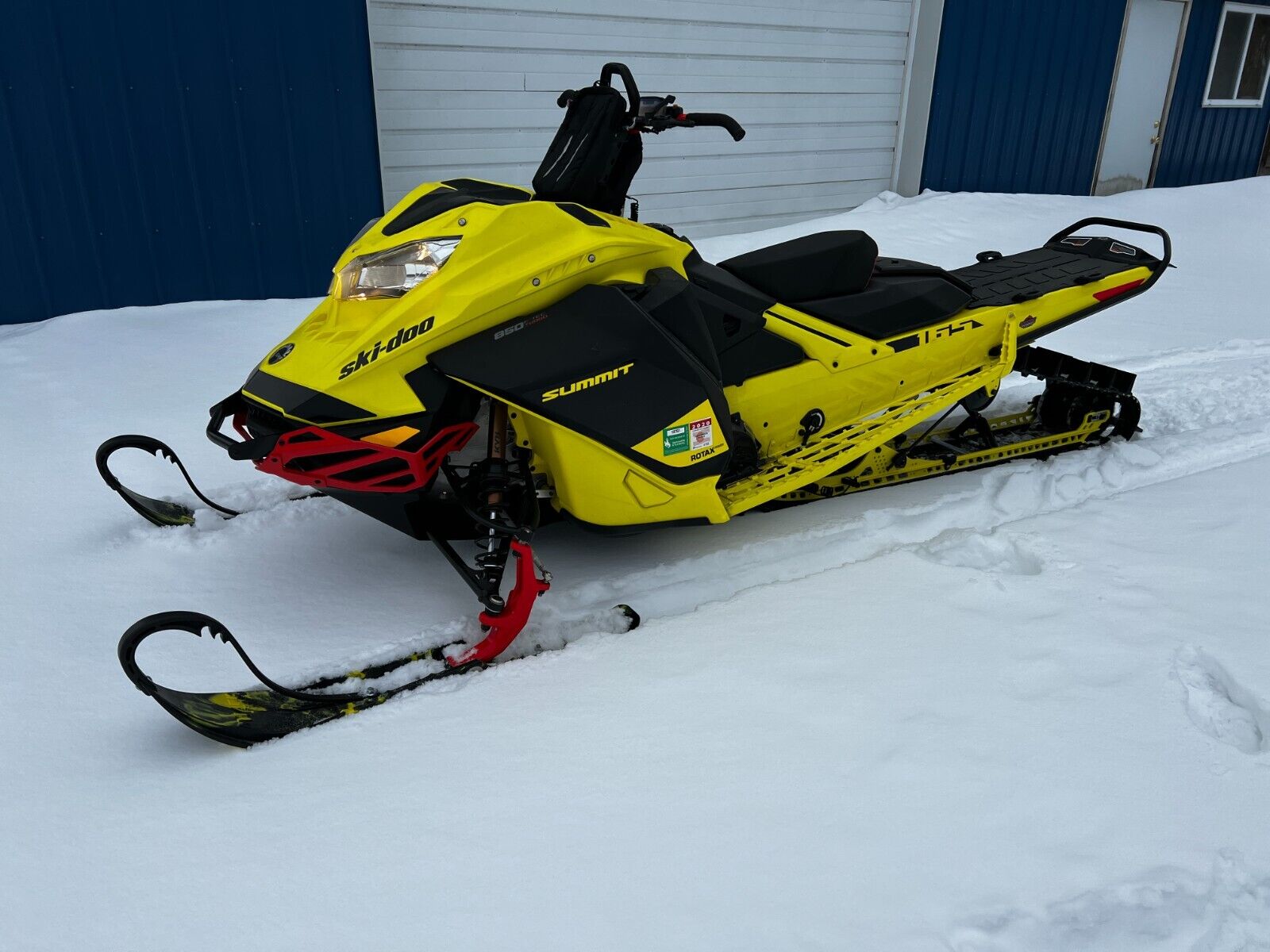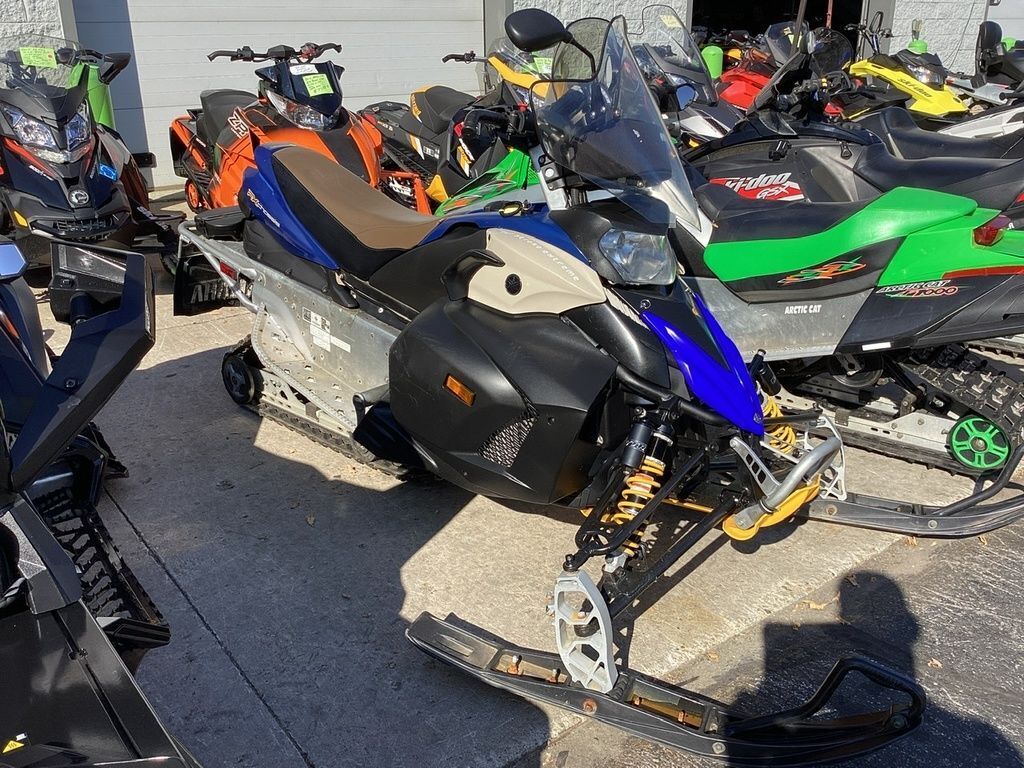-40%
2005 YAMAHA VECTOR RS 1000 SNOWMOBILE SLED APEX NYTRO RTX WARRIOR LOW MILES
$ 660.52
- Description
- Size Guide
Description
2005 YAMAHA VECTOR 1000CC 120HP 4-STROKE SNOWMOBILE. TRACK IS IN EXCELLENT SHAPE. HOOD SHINES LIKE NEW... PUSH BUTTON ELECTRIC START... MACHINE RUNS STRONG AND SMOOTH... SNOW READY!!No Reserve Auction BID TO WIN!!!!!!!!!!
Clear TITLE in hand!!
Contact Power Sports Boyz sales associate Steve B 518-881-8202 with questions or concerns!!!!!!!!!!!!!!!!!!!!!!!!!!
Last season Yamaha introduced their 120 HP three-cylinder 4-stroke in the RS Vector, and all of a sudden 4-stroke became mainstream. Instead of being an oddity or a hyper-powered rocket, the RS Vector was aimed at the heart of the market, the 120 HP class. Owners went wild with the package, and if there was one thing they asked most often, it was “why can’t I get a Vector with the Mono-Shock RA rear suspension?â€
Ask and we shall receive. In addition to the base-model RS Vector (recently named a Consumer’s Digest Best Buy), Yamaha now offers us the Mono-Shock RA rear suspension in the RS Vector ER and the pimped RS Vector GT. They all have electric start, but the ER and GT get reverse added along with the Mono Shock RA rear suspension. The GT takes it one notch further for even more calibration control with a set of mighty trick GYT remote reservoir clicker-adjust shocks on the front suspension.
The base RS Vector is very similar to the 2005 intro, fitted with the excellent ProActive torsion spring rear suspension. While similar in appearance to the torsion spring suspensions used by the other three sled makers, this one has many detail differences. A “floating link†connects the front and rear shocks and varies the shock speeds to optimize the ride. A three-position Bottoming Stopper changes the contact point of the long arm of the torsion spring, providing a higher rate at the end of the suspension travel for improved resistance to bottoming.
This suspension strokes nicely, and is actually easier to set really soft in comparison to the Mono Shock RA. Does this mean the Pro Active is softer overall? Not really, it can also be set very firm (a re-calibrated version is in the Nytro) so the window of adjustment is actually broader. It is still a two-way coupled suspension, and you can still adjust the amount of weight transfer, but as you increase the transfer the overall suspension action will become softer. Compared to the Mono Shock RA, adjustments to the weight transfer on this suspension will have more of an effect on the ride quality.
Usually base models are fitted with junk shocks, but the RS Vector has aluminum body HPG shocks on the rear arm and on Yamaha’s second-generation front suspension. This front end (with a slightly higher roll center) demonstrated last season greater stability and flatter cornering than the original RX-1. This front suspension is now also found on the Apex models as well.
Other tweaks for 2006, compared to the 2005 intro, include new brakes, wide floorboards with traction, and a lighter magnesium chaincase cover. Ounce by ounce, weight is trimmed away.
RS Vector ER
Last year we wondered why we couldn’t get the Mono Shock RA rear suspension in a Vector; here it is! The RS Vector ER (,699) adds 0 to the price tag for the addition of reverse and the Mono Shock RA rear suspension. This suspension provides remote adjustability for tuning to the conditions or your riding style, and delivers superior ride comfort without sacrificing weight transfer characteristics.
Right there on the left side of the tunnel is a great big dial (Remote Damping Force Adjuster) with 20 clicks of damping adjustment, allowing you to set the ride comfort for weight, style or conditions.
The RA damping dial controls both compression and rebound damping of the 46mm aluminum body KYB shock, with each position making a real difference. Each click has more affect on the rebound damping than compression, providing a 30% range of adjustment. This can be used to select ride comfort based on riding style, conditions or rider weight. Spring preload must first be set, using a measurement on the control rod to determine proper ride height. A new style control rod also lets you adjust the amount of transfer, with little affect on the ride quality.
By making the ride and transfer adjustments more independent of each other, this design provides improved acceleration, improved throttle response and brings back more of the three-way steering behavior. This is a key difference from this suspension to all others – the main benefit of the Mono Shock rear suspension is the ability to adjust the ride quality independently of the weight transfer.
RS Vector GT
One notch higher yet is the Vector GT, aimed at the groomed trail veteran who wants all of the four-stroke benefits but also wants to be able to have greater control over the suspension calibration.. This premium scooter is trail sled deluxe, fitted with the Mono Shock RA in the rear and GYT-R clicker piggyback shocks up front for the ultimate in suspension adjustability and comfort. The range of adjustability is truly impressive, set it soft or firm, you decide.
These GYT-R piggyback shocks offer 12 clicks of compression damping adjustment (providing a 30% range of adjustability) and 20 clicks of rebound damping adjustment (and a 70% range of adjustability) for the ultimate in suspension tuning capability. The piggyback reservoir adds oil volume and resistance to fade in extreme riding conditions. Combined with the 23-position adjustability of the rear suspension, the GT lets you really dial in the calibration to your liking. And it works.
Genesis 120 4-Stroke Engine
The three-cylinder Genesis 120 4-stroke earned great respect in its first season. Yamaha calls this a long stroke design triple, with a 65mm stroke (compared to the 58mm stroke of the RX-1). Yamaha was seeking a more compact engine design, and the overall engine profile is a bit smaller. A balancer shaft helps cancel vibrations for smooth power. Magnesium covers (oil pump cover, cylinder head cover and crankcase cover) all help to reduce overall weight, making it a full 22 pounds lighter than the RX-1 engine. The engine is tipped back 7 degrees more than the RX-1, providing a more-centered engine mass.
Since this engine spins at a lower rpm than the RX-1, it is fitted with four valves per head, driven by dual overhead cams. Yamaha tells us five valve heads make very little difference in lower revving rpm engines, thus the four valve head is best suited for this package. Torque peaks at 7000 RPM, with HP peaking at 8600 RPM, making this thing pull like crazy! The primary clutch mounts directly to the crankshaft, so there’s no gear reduction unit. This direct clutch mounting saves weight, as does trimming a cylinder. The oil pump cover, cylinder head cover and crankcase covers are all made from magnesium, being lighter than aluminum.
Of course, you get all of the 4-stroke benefits; 4-stroke reliability, excellent fuel economy, less smoke & smell and standard electric start, with the exhaust routed under the seat and out the back. Three Keihin 40mm constant velocity carbs provide improved throttle response vs. Mikunis, and are fitted with a throttle position sensor and are liquid heated with impressive response and fuel economy.
Riding Impressions
On groomed trails, owners of last year’s model report extraordinary fuel economy and durability. Momentary engagement of the TORS throttle safety system was about the biggest problem, along with some stray noises from the primary clutch (both of which have been addressed by Yamaha service). Fuel economy reports of 15-19 mpg were common, with some misers getting 20 mpg.
Our riders like these models on groomed trails, but as the trails get rougher and the ride gets longer we still experience more fatigue than on the other sleds from throwing around the mass. Many days you don’t notice it, and Yamaha is quick to point out it is only a few pounds heavier than competitive models, but we compare it to the F6 and it is heavier, period. Ride them side by side for 300 miles in the rough and you’ll realize these are trail sleds, not cross country racers. The seating position is traditional, no rider forward ergonomics here.
From a durability, quality, reliability (DQR) standpoint, the Vector models are rock solid. More (any) storage would be nice, but here you can turn the key and go in complete confidence with Yamaha predictability and reliability. The 4-stroke benefits are undeniable. Clean and quiet with broad power; as consistent and reliable of performance as you can get. No need to add smelly oil. Excellent fuel economy. Smooth engine. Snappy throttle response. Broad flat torque. It’s all in there. High-mile riders are hard pressed to find a better trail sled.
We’re not totally convinced the Vector ER is worth 0 more than the base model, as the actual difference in suspension performance isn’t as great as one would suspect. When we add another 0 to the Vector GT, we end up with the better package of the three, providing reverse, trick shocks up front AND the Mono Shock RA rear suspension for 00 more than the base model. Getting these two shocks for only 0 is a STEAL! The GT truly is the gem.
The 2006 Yamaha RS Vector retails for ,999 – this model provides one of the best values in all of snowmobiling. The 2006 RS Vector ER goes for ,699 and the outstanding RS Vector GT goes for ,999.
2005 Yamaha RS Vector Specifications
Identification
Model Type
Trail
Insurance
Engine:
Engine Type
Horizontal In-line
Cylinders
3
Engine Stroke
4-Stroke
Valve Configuration
DOHC
Displacement (cc/ci)
973 / 59.4
Starter
Electric
Turbocharged
No
Carburetion Type
Carburetor
Transmission:
Reverse
No
Technical Specifications:
Length (ft)
9.04
Width (in/mm)
47.4 / 1204
Height (in/mm)
46.7 / 1186.2
Maximum Ski Stance (in/mm)
42.8 / 1087.1
Minimum Ski Stance (in/mm)
42.8 / 1087.1
Dry Weight (lbs/kg)
536 / 243
Fuel Capacity (gal/l)
10 / 37.9
Seats:
Number Of Seats
1
Exterior:
Ski Material
Plastic
Skag Material
Carbide
Drive Line:
Track Length (in/mm)
121 / 3073.4
Track Width (in/mm)
15 / 381
Lug Height (in/mm)
1.25 / 31.8
Glass:
Height
Mid
Convenience:
Heated Hand Grips
Standard
We are a Registered NYS Power sports Dealer and NYS Residents must pay Sales Tax and Registration Fee.
Terms of Sale:
Shipping
OPTIONAL SHIPPING!!!
Local buyers are urged to come and take a look at how nice this machine really is. Out of state bidders check out my feedback and bid with confidence I can ship this machine with in 200miles of 12306 door to door for a fee. Call for details..
Loading dock and forklift available at our business we can assist with u-shippers if required.























